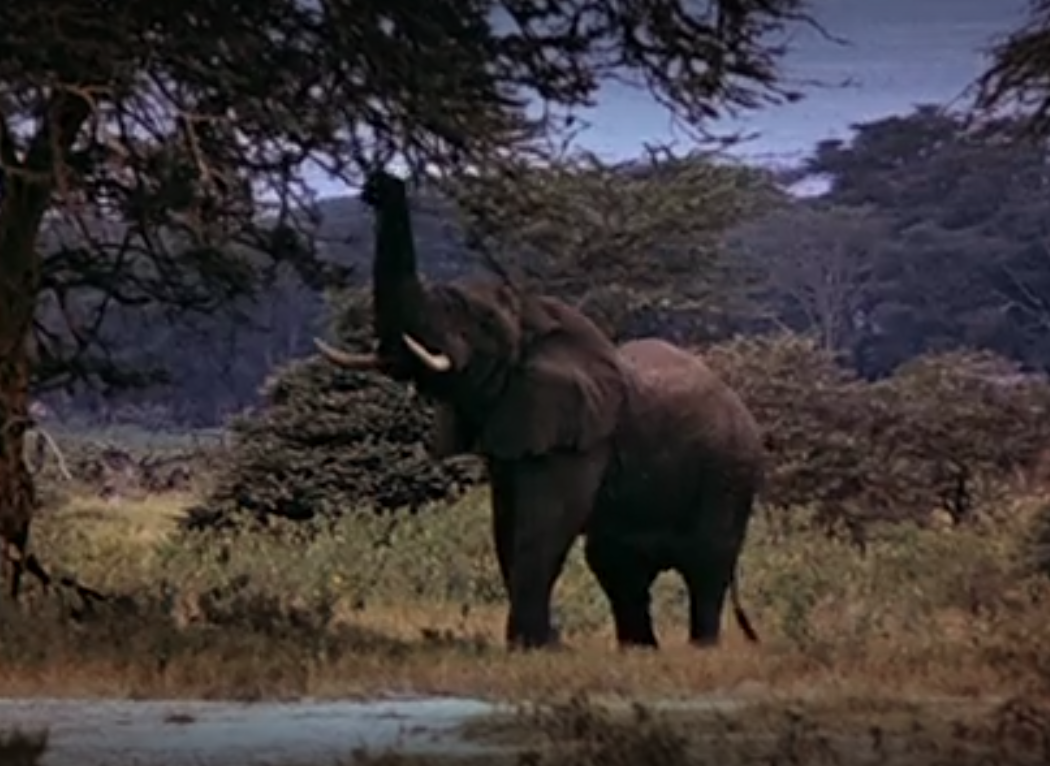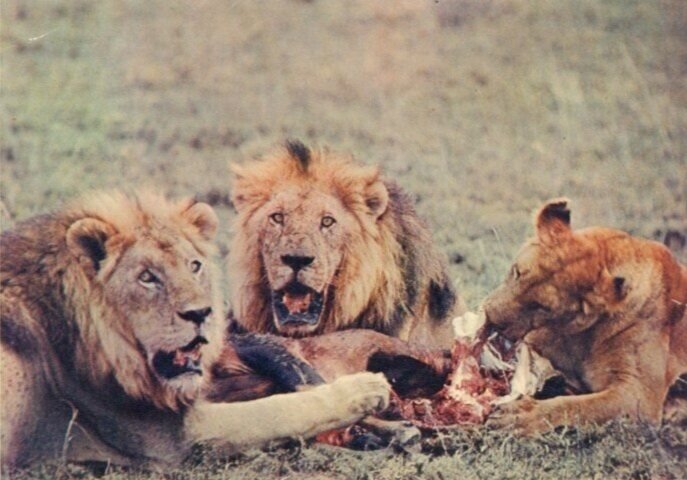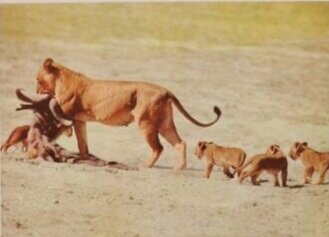Review: The African Lion (DMC #22)
Happy Friday to all you Disnerds out there! Welcome back to the blog, where today we are reviewing the 22nd film in the Disnerd Movie Challenge, The African Lion. This is the third feature-length film in the True Life Adventures series. Follow along with our synopsis if you’ve never seen this, or skip ahead to the review.
Synopsis
Deep in the heart of Africa lies Mount Kilimanjaro. It is here, in its shadow, where many exotic animals roam, including the king of beasts - the African lion. As a wide, open plain, many species live alongside the lion, only to become its prey at any given moment. The wildebeest, zebra, waterbuck, antelope, and other grass-eaters will eventually be hunted, while the smaller gazelle and dik-dik are hardly a meal. Others, like the buffalo, are given cautious respect. It’s also home to the giraffe, whose long neck gives it a great vantage point to spot predators and its equally long legs an easy way to escape harm. Rhinos are avoided due their unpredictability, even by the lion. The lions may spend most of their days relaxing, but none may be considered more lazy than the male. The lionesses do the bulk of the work by hunting for food, fighting off invading lions, and often raising and caring for cubs. Out of all the creatures on the plains, if there’s one species that the lion might concede to, its the African elephant. This enormous animal is unique in how it lives, thanks to its long, multi-purpose trunk.
Hippos and crocodiles roam the rivers and lakes, far too removed to concern themselves with the land-dwellers. Baboons scale the cliffs and plateaus, where they remain safe from the lions, who’d much rather choose easier prey anyway. Birds are abundant as well, including the secretary bird, courser, and the flightless ostrich. With all these animals around, nature has devised a plan that keeps the circle of life going. Other large cats include the cheetah and the leopard, also fellow hunters of wildebeest and other larger species. Various scavengers call this area home as well, such as vultures, jackals, and hyenas. They scrounge for scraps leftover by the lionesses, and the hunt continues until the lion pride has been satisfied. The most difficult challenge in this land is the dry season. At this point, all land animals are equal in their fight for survival as they search for water. Areas formerly filled with water turn into deadly mud holes, and dust storms race across the land. The conditions bring in swarms of locusts that feast on the grass, affecting many grass-eaters. Still, nature will continue to provide to its creatures once the wet season arrives. Tropical rains eventually bring new life to the grasslands. The grass-eaters return, the meat-eaters hunt, and the cycle continues again. And through it all, the lion remains the king of beasts.
Thoughts Before Watching
Kevin: Like the other True Life films, I’ve never seen this. The preview image has a couple of cute lion cubs, and just going off the description it sounds more interesting, so those are a couple pluses. Honestly though, I’m not excited to watch this after coming off our previous review. Still, it can’t be worse than last year’s remake of The Lion King, can it?
Megan: Similar to what Kevin just said, it’s a little hard to go from something as amazing as Lady and the Tramp to yet another True Life Adventure documentary. I’ll be honest, when Kevin and I first embarked on this challenge I insisted that the documentaries had to be included because they were released in theaters, but now I am vaguely regretting that I was so insistent. These early documentaries are nowhere near the more recent nature documentaries under the Disney Nature umbrella. Still, this one does seem like it might have more of a singular focus on lions, so perhaps we’ll get a little bit more plot out of this one. At the very least, I do like lions…
Thoughts After Watching
Just a little misleading…
Kevin: So this wasn’t at all worse than the live-action The Lion King, but it’s not exactly better. No reason to compare, however, since this is a different style of film. I was surprised at the end of it, though; the description made it sound like we’d be following a couple of wildlife experts with a small camera crew as they talk about the various animals. It also sounded like it would be entirely focused on a small family of lions. Ultimately, the movie wasn’t really any of those specifically. It makes sense that the style of this documentary is similar to the other True Life Adventures films by opening with a familiar introduction, having the same narrator, and ultimately a similar message about how nature and wildlife interact. These are clearly a series and they have a format to them. Buuuut… I’m kind of disappointed by this. Don’t get me wrong, there’s definitely a few interesting things and some good shots of animals here, but I was looking forward to a break from the previous mold by getting to hear the opinions of the Milottes (the wildlife experts who filmed this). It’s a small complaint though.
Megan: Like Kevin, I had been expecting this film would follow a single family of lions over the course of their life, but having watched the previous True Life Adventure films I was pretty sure we wouldn’t get any human experts on screen, even though the Milottes were named in the description. While I still would have liked to see a more narrow focus on just the lions, I do appreciate the inclusion of the other African animals. I can see where this documentary could be a useful educational video for kids learning about these animals for the first time. Also, can I just point out how so many of these animals could seem as foreign as dinosaurs to someone who’d never seen so much as a photo of one of these creatures? I mean look at the rhino (for one thing, I had no idea their horns could get so incredibly long and sharp!), the elephants and all the ways they use their trunks (nose, hose, hand, arm, etc.), even the giraffes and the ostriches. I wonder what it must have been like ages ago before internet and cameras when people would visit the African plains and bring back stories of these creatures.
A different tone
Kevin: In spite of the movie not being what I expected, it’s quite clear that this was made differently than the previous two entries in the series. They all begin with a text-on-the-screen introduction that summarizes what the film is about, but this is the first one that calls out the amount of time that was spent working on the production (3 years). That amount of time seems to have made a difference, as The African Lion is shot in different ways than The Living Desert and The Vanishing Prairie. Following the camera as a cheetah chases down its prey, or watching the lion cubs play with each other, there’s something about these shots that doesn’t feel as staged as the last two. Also gone this time is the humor that was more prominent in the other movies, and while I enjoyed that aspect, I think The African Lion benefits by not having that humor around. There are still some funny moments, like the baboons playing with each other, but overall the filmmakers chose a different route here that keeps the focus right on the titular animal, with some attention given to other animals as well. I think this is probably the film’s best quality.
Megan: Agreed! As much as I enjoyed the humor in the previous documentaries, those were also the elements that received the most criticism when the films were initially released. I’m guessing Disney decided to take a more academic approach this time. There’s still some humor in the narration, but no gimmicky edits (like playing a clip forward and backward repeatedly to make scorpions “dance” longer) and fewer humorous musical cues.
Rated G…for gore?
Megan: Given that Disney is generally pretty strict about what can and cannot be shown in its films, I have to say I was a little surprised at how many of the predators killed prey on camera. In the previous two documentaries we really only saw insects and maybe a snake or two being eaten by another animal, and if it was a mammal like a bat it was shown from so far away that we didn’t see any blood or guts. I knew going into this that by their nature lions kill and eat antelope and other grazing mammals, so I was curious how or if Disney would show that. At first we see a leopard take down what looks like a baby wildebeest, but the scene is largely obscured by a tree—even when the leopard carries its prey into the branches. I started to think this would be how kills would be portrayed in the rest of the film, but then we see the cheetah take down its prey and in the next clip the cheetah has blood all over its face after eating, with the bloody carcass visible. Later we see lions killing, eating, or dragging the carcasses of zebra, giraffe, wildebeest, and other animals. In one scene we even see the exposed bones of a half-eaten carcass as a lioness drags it home to her babies. Now I’ll admit that I watched a lot of nature documentaries as a kid, and scenes like this were not uncommon on those shows. What surprises me is that these clips made it into a Disney documentary when the company (especially now) is so protective of its brand and its kid-friendly image. I mean even riding the Jungle Cruise at Disneyland the skipper points out that the (ahem, dead) zebra is just sleeping next to the family of lions. While other old films on Disney Plus include a warning about outdated cultural depictions, I would have expected this to include an animal violence warning. Perhaps they assume anyone watching a nature documentary knows what they’re getting into?
Lionesses rule, but fail the Bechdel test.
Megan: It’s not really the lionesses’ fault—it’s the filmmakers’. Once again this documentary is narrated by a man, thus there is no opportunity for two female characters to speak to each other. While I know that in the wild the lionesses do the bulk of the hunting while the male lions do very little, I still found some of the narrator’s commentary on male/female lion relationships to be bordering on sexist. The male lions were branded as lazy, wondering what’s taking so long with dinner, while the female lions were shown doing all the work and, in one case, pushing the male lion out of her spot. While I appreciate framing the female lions as having the power, I still found it troubling that the male lion’s actions (or lack thereof) were likened to a stereotypical husband who comes home and lazes on the couch with a beer while asking his wife what’s for dinner. It came across as almost permissive—implying that the male’s actions were okay because, well, that’s a male for you, and boys will be boys. Again, this seems like it was largely created by men, so we’re seeing everything through the male gaze. While it’s not always problematic, we can see how it does color the perception of something you’d think could be objective, like the observation of animals in their natural environment.
Kevin: It’s too easy to think of The Lion King after watching this. One thing of note about that film is how it really doesn’t portray its male lions accurately. This isn’t to say Mufasa or Simba are bad characters, but just that their heroism is obviously meant to go beyond the real and into the fantasy. This documentary (and, frankly, many others to come later) have pointed out what Megan said above, which is that the king basically sits on his throne while leaving the females to do the chores. In fact, one could argue that Scar is the most realistic depiction of a male lion by… well, sitting on his throne while Sarabi and the lionesses do the work. I will admit it seems just a tad silly to point this out, because The Lion King is not meant to be realistic. But, in coming away from The African Lion with a fresh take, I couldn’t help but think about this.
It must be hard to be a nature documentary filmmaker.
Megan: Kevin and I both found it hard to watch the scene where the rhino was stuck in the mud and slamming its head on the ground in an attempt to get out or perhaps alert someone to come to its aid (though clearly the animal kingdom has an every-creature-for-itself mindset since no creature ventured to help). It made me wonder about the ethics of a documentary filmmaker. While I understand the importance of observing animals in their natural environments (and, you know, not getting between a lion and its dinner), I think I would find it incredibly hard not to try to help an animal like that rhino if I were the one behind the camera. Granted there’s not much I alone could do to help a giant creature like a rhino, but I imagine the filmmakers must have had a vehicle nearby, or some rope. Could they have gone back to wherever they were staying to get help for the rhino? Watching this film today, knowing that rhinos are endangered species, it makes it even harder to watch, and it left me wondering what would happen to the poor rhino after the cameras stopped rolling.
Kevin: I agree completely. I kept hoping that rhino would get a happy ending. But then, this is nature, and nature is messy. For all that humans have done to harm it, we believe there is still so much we can do to help, too. In fact, I think we’re doing a lot more now than before. With that said, these older films can come off dry at times. I can appreciate the level of detail and work the filmmakers put into this, but it really is hard to enjoy this after a much more feel-good story like Lady and the Tramp. I’m also just far more interested in contemporary documentaries, and as we continue to understand our world more and more, old films just can’t hold a candle to new ones . This one is dated just like The Living Desert and The Vanishing Prairie, as seems to be common with many live-action, non-fiction films from this decade. Though, as with any documentary, I think future generations can find some educational value even if it is watched only once.
Verdict
Megan: 3
Kevin: 3
Final Score: 3
What did you think of The African Lion? Were you constantly reminded of The Lion King? Share your thoughts in the comments!




